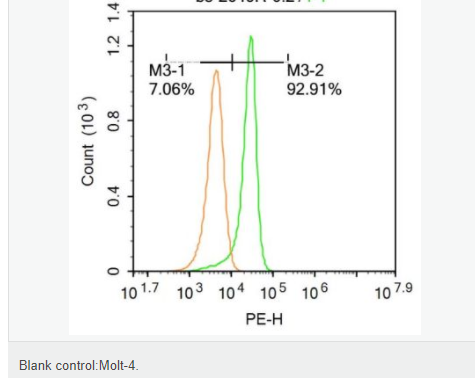

貨號(hào)
產(chǎn)品規(guī)格
售價(jià)
備注
BN41844R-50ul
50ul
¥1486.00
交叉反應(yīng):Human,Mouse,Rat(predicted:Dog,Cow,Horse) 推薦應(yīng)用:WB,ELISA
BN41844R-100ul
100ul
¥2360.00
交叉反應(yīng):Human,Mouse,Rat(predicted:Dog,Cow,Horse) 推薦應(yīng)用:WB,ELISA
BN41844R-200ul
200ul
¥3490.00
交叉反應(yīng):Human,Mouse,Rat(predicted:Dog,Cow,Horse) 推薦應(yīng)用:WB,ELISA
產(chǎn)品描述
| 英文名稱(chēng) | Lck |
| 中文名稱(chēng) | 淋巴細(xì)胞特異性蛋白酪氨酸激酶抗體 |
| 別 名 | p56-LCK; p56-LCK; Lymphocyte cell-specific protein-tyrosine kinase; LSK; T cell-specific protein-tyrosine kinase; Lck p56; Lymphocyte Specific Protein Tyrosine Kinase; Membrane associated protein tyrosine kinase; Oncogene lck; P56 LCK; p56(LSTRA) protein tyrosine kinase; p56lck; pp58 lck; pp58lck; Proto oncogene tyrosine protein kinase LCK; Protooncogene tyrosine protein kinase LCK; T cell specific protein tyrosine kinase; T lymphocyte specific protein tyrosine kinase p56lck; YT 16; YT16; LCK_HUMAN. |
| 研究領(lǐng)域 | 細(xì)胞生物 信號(hào)轉(zhuǎn)導(dǎo) 激酶和磷酸酶 |
| 抗體來(lái)源 | Rabbit |
| 克隆類(lèi)型 | Polyclonal |
| 交叉反應(yīng) | Human, Mouse, (predicted: Rat, Dog, Cow, Horse, ) |
| 產(chǎn)品應(yīng)用 | WB=1:500-2000 ELISA=1:5000-10000 Flow-Cyt=0.2ug/test not yet tested in other applications. optimal dilutions/concentrations should be determined by the end user. |
| 分 子 量 | 56kDa |
| 細(xì)胞定位 | 細(xì)胞漿 細(xì)胞膜 |
| 性 狀 | Liquid |
| 濃 度 | 1mg/ml |
| 免 疫 原 | KLH conjugated synthetic peptide derived from human Lck:421-509/509 |
| 亞 型 | IgG |
| 純化方法 | affinity purified by Protein A |
| 儲(chǔ) 存 液 | 0.01M TBS(pH7.4) with 1% BSA, 0.03% Proclin300 and 50% Glycerol. |
| 保存條件 | Shipped at 4℃. Store at -20 °C for one year. Avoid repeated freeze/thaw cycles. |
| PubMed | PubMed |
| 產(chǎn)品介紹 | This gene is a member of the Src family of protein tyrosine kinases (PTKs). The encoded protein is a key signaling molecule in the selection and maturation of developing T-cells. It contains N-terminal sites for myristylation and palmitylation, a PTK domain, and SH2 and SH3 domains which are involved in mediating protein-protein interactions with phosphotyrosine-containing and proline-rich motifs, respectively. The protein localizes to the plasma membrane and pericentrosomal vesicles, and binds to cell surface receptors, including CD4 and CD8, and other signaling molecules. Multiple alternatively spliced variants, encoding the same protein, have been described. [provided by RefSeq, Jul 2008]. Function: Non-receptor tyrosine-protein kinase that plays an essential role in the selection and maturation of developing T-cells in the thymus and in the function of mature T-cells. Plays a key role in T-cell antigen receptor (TCR)-linked signal transduction pathways. Constitutively associated with the cytoplasmic portions of the CD4 and CD8 surface receptors. Association of the TCR with a peptide antigen-bound MHC complex facilitates the interaction of CD4 and CD8 with MHC class II and class I molecules, respectively, thereby recruiting the associated LCK protein to the vicinity of the TCR/CD3 complex. LCK then phosphorylates tyrosines residues within the immunoreceptor tyrosine-based activation motifs (ITAM) of the cytoplasmic tails of the TCR-gamma chains and CD3 subunits, initiating the TCR/CD3 signaling pathway. Once stimulated, the TCR recruits the tyrosine kinase ZAP70, that becomes phosphorylated and activated by LCK. Following this, a large number of signaling molecules are recruited, ultimately leading to lymphokine production. LCK also contributes to signaling by other receptor molecules. Associates directly with the cytoplasmic tail of CD2, which leads to hyperphosphorylation and activation of LCK. Also plays a role in the IL2 receptor-linked signaling pathway that controls the T-cell proliferative response. Binding of IL2 to its receptor results in increased activity of LCK. Is expressed at all stages of thymocyte development and is required for the regulation of maturation events that are governed by both pre-TCR and mature alpha beta TCR. Phosphorylates other substrates including RUNX3, PTK2B/PYK2, the microtubule-associated protein MAPT, RHOH or TYROBP. Subunit: Binds to the cytoplasmic domain of cell surface receptors, such as AXL, CD2, CD4, CD5, CD8, CD44, CD45 and CD122. Also binds to effector molecules, such as PI4K, VAV1, RASA1, FYB and to other protein kinases including CDK1, RAF1, ZAP70 and SYK. Binds to phosphatidylinositol 3'-kinase (PI3K) from T-lymphocytes through its SH3 domain and to the tyrosine phosphorylated form of KHDRBS1/p70 through its SH2 domain. Binds to HIV-1 Nef through its SH3 domain. This interaction inhibits its tyrosine-kinase activity. Interacts with SQSTM1. Interacts with phosphorylated LIME1. Interacts with CBLB and PTPRH. Interacts with RUNX3. Forms a signaling complex with EPHA1, PTK2B AND PI3-KINASE; upon activation by EFNA1 which may regulate T-lymphocyte migration. Associates with ZAP70 and RHOH; these interactions allow LCK-mediated RHOH and CD3 subunit phosphorylation in the presence of functional ZAP70. Subcellular Location: Cytoplasm. Cell membrane; Lipid-anchor; Cytoplasmic side. Note=Present in lipid rafts in an inactive form. Tissue Specificity: Expressed specifically in lymphoid cells. Post-translational modifications: Autophosphorylated on Tyr-394, increasing enzymatic activity, this site is dephosphorylated by PTN22. Phosphorylated on Tyr-505 by CSK, decreasing activity. Dephosphorylated by PTPRC/CD45. Myristoylation is required prior to palmitoylation . Palmitoylation regulates subcellular location. DISEASE: Note=A chromosomal aberration involving LCK is found in leukemias. Translocation t(1;7)(p34;q34) with TCRB. Similarity: Belongs to the protein kinase superfamily. Tyr protein kinase family. SRC subfamily. Contains 1 protein kinase domain. Contains 1 SH2 domain. Contains 1 SH3 domain. SWISS: P06239 Gene ID: 3932 Database links: Entrez Gene: 3932 Human Entrez Gene: 16818 Mouse Omim: 153390 Human SwissProt: P06239 Human SwissProt: P06240 Mouse Unigene: 470627 Human Unigene: 293753 Mouse Unigene: 22791 Rat Important Note: This product as supplied is intended for research use only, not for use in human, therapeutic or diagnostic applications. Lck淋巴細(xì)胞特異性蛋白酪氨酸激酶,是近年來(lái)發(fā)現(xiàn)的一種非受體型蛋白酪氨酸激酶,存在于T淋巴細(xì)胞及其它一些非T淋巴細(xì)胞內(nèi),參與細(xì)胞的信號(hào)轉(zhuǎn)導(dǎo)過(guò)程,在多種生理及病理過(guò)程中發(fā)揮著重要作用。 |
